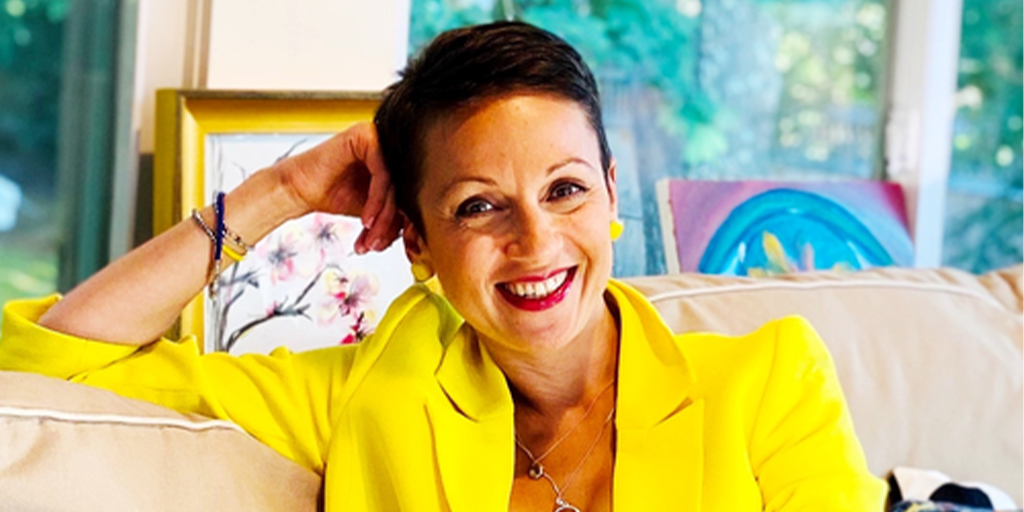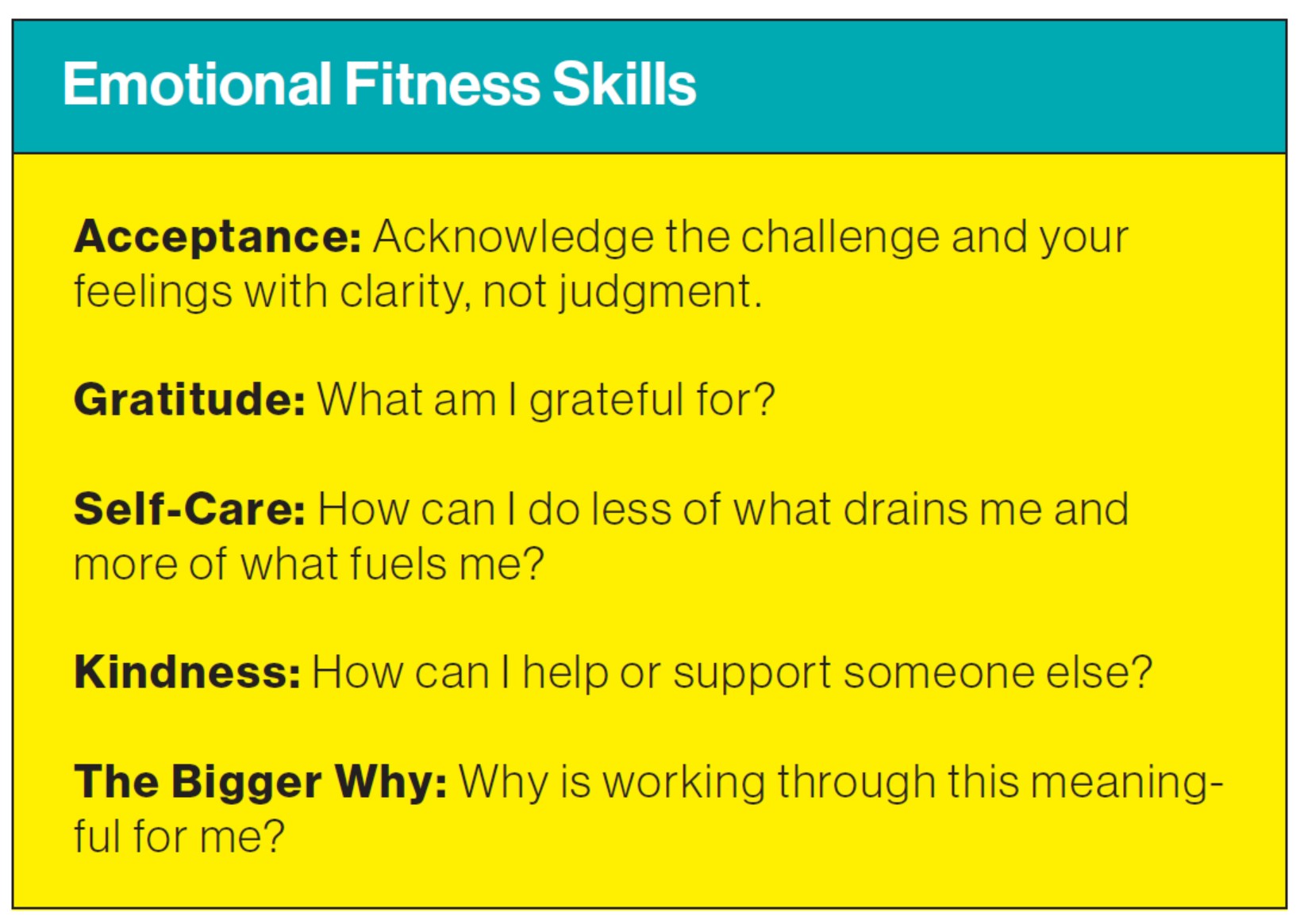
In your book you describe how you burned out at the age of 35 and went on to create The Happier Method. Describe your journey.
After achieving tons of career success as a business executive, venture capitalist, consultant and entrepreneur, I completely burned out at 35. This was the scariest time in my life. I never thought I could burn out because only ‘weak’ people burned out, and I was a ‘tough cookie.’ The biggest lesson I learned on my journey to wellness is that emotional fitness is a skill you can strengthen through practice.
Based on my own harrowing experience and research findings from Neuroscience and Psychology, I created The Happier Method, a set of skills and practices to help people strengthen their well-being and emotional fitness. I (unknowingly) created this method to help myself heal, and I have since taught it to tens of thousands of people. At its core, it’s about making small daily changes in all areas of your life to help you struggle less and thrive more.
I called my book The Awesome Human Project because every single one of us has tremendous capacity to live a full life and be a force of good for others. But we are also human, which means we aren’t perfect: We mess up and we need to practice skills to remove mental blocks that hold us back. There has been this idea that people should leave their emotions at the door or put them on the shelf — particularly at work. But it just doesn’t work that way. We need to practice emotional fitness in the same way as physical fitness. If we are not emotionally fit, we can’t bring our best to ourselves — or to the people and work that we care about.
Is it possible to edit our thoughts and retrain our brain to be less negative?
The human brain has one job: to keep us safe from danger and help us survive. Your brain wants to protect you: Things that are familiar, positive or ‘good’ are boring for the brain. We notice things that are wrong or negative much more than we notice things that are right. So we pay more attention to, and remember, the negative stuff. This is known as the negativity bias.
Understanding that many of your thoughts are not rational, not based
on fact and not helpful to you takes training and practice.
It’s also important to understand that our brains hate uncertainty. When they encounter it, they don’t know what to do. Research shows that we would prefer to know for sure that something bad is going to happen, rather than live with uncertainty. Between the negativity bias and the fear of uncertainty, the brain easily goes to fear-based worst-case scenarios.
Once we understand how our brain reacts to possible or perceived danger, we have something very powerful: the awareness to edit our thoughts. Just because a thought comes into your brain doesn’t mean you have to go along with it. You can practice editing your thoughts by asking questions like, ‘Is this actually true?’ And ‘Is this helpful to me?’ Often we will find that it’s neither. Asking these two questions is a powerful practice for editing our thoughts.
Understanding that many of our thoughts are not rational, are not based on facts and are not helpful to ourselves or others takes training and practice. But when you learn to edit your thoughts consistently, it becomes easier to do in the moment and helps you struggle less, even when life gets challenging.
Most of us have used whiteboards at work at some point, but what is an ‘emotional whiteboard’?
The emotional whiteboard is the concept that we are always sharing our emotions with others. As human beings, we’re great at sensing each other’s emotions — and furthermore, our emotions are contagious. When you’re around happy people, you tend to be happier yourself. If you work for a leader with a great sense of well-being, you’re more likely to feel the same. When people don’t have full context around their emotions — for example, if you feel tense but don’t know why — that’s when the negativity bias kicks in. You sense something is amiss and then catastrophize or struggle with something you think you might have done or failed to do.
Practicing emotional openness and sharing your emotional whiteboard is an act of kindness. Rather than allowing people to ruminate on what could be going wrong, it saves them the struggle and creates a culture of psychological safety — whether it be within a family or a team at work. It’s not easy, but it is very powerful.
A huge body of research shows that the most trusted leaders and the ones with the most effective teams are those who are emotionally aware. These people are open and honest about their own challenges and feelings, and they create a safe space for their team to do the same. Pretending to feel good when you don’t is a form of emotional labour known as ‘surface acting.’ Over time, this can be very damaging and is one of the leading causes of burnout. That’s why vulnerability, openness and emotional awareness are essential leadership skills.

How are emotional fitness and self-care connected?
First of all, self-care is a skill. I define it as ‘the skill of fueling your emotional, mental and physical energy.’ A person needs energy to do their job as a leader, a parent or a coworker. Your energy as a human being is your fuel. About two-thirds of the things we do throughout the day require emotional energy. Self-care is mostly seen as some sort of prize you win once everything else is done. I’m on a mission to change that.
I want people to make self-care a daily practice. We need to ensure our reservoir of emotional, mental and physical energy is full, because you cannot give what you don’t have. If you’re depleted as a leader, you can’t make the right decisions; and if you’re running on empty as a parent, you can’t show up in a meaningful way. Self-care is the opposite of selfish; it’s actually an act of kindness and service to others.
Speaking of service to others, tell us about ‘intentional kindness’ and its effects on stress.
When you do something kind or reach out and connect with another person, your brain releases oxytocin and serotonin, two neurotransmitters known as ‘the feel-good hormones.’ This is how our brain rewards us for kindness. But it’s all too easy to put kindness on the backburner, especially when we’re busy.
I invite everyone to think of intentional kindness as a skill. It doesn’t take a lot to practice. It’s about little things like checking in, asking how someone is feeling, listening mindfully to their response and being present with people. Small acts of kindness and compassion, understanding how others are struggling and trying to find a way to support them, ends up being a gift to ourselves. That’s because when we feel connected to each other, we thrive. We can’t function when we feel isolated from each other. Connection is essential, and even tiny acts of kindness and compassion fuel that. On top of all that, acts of kindness have been shown to increase self-esteem and compassion and to decrease stress.

What is ‘the bigger why’ and how can we find it?
The Bigger Why is the skill of connecting to your sense of meaning and purpose. You can find this by looking at all the things you’re already doing — your daily activities and the stuff on your to-do list — and asking yourself how all these things contribute to others or help you reach a meaningful goal. Working on a challenging project at work? That helps colleagues, your organization and your customers. Grocery shopping? This helps you show love for family and friends. It’s not about quitting your job and travelling the world in search of meaning; the Bigger Why might be right there under your nose. It’s where human beings find their sense of purpose within their own lives.
Ultimately, being an Awesome Human is a lifelong project. How can we keep it going?
Like anything new, it takes commitment to make you and your emotional fitness a priority. There is no magic formula, but regular practice will support you to thrive more and struggle less. It will help you create a more supportive relationship with your thoughts, your emotions and other people.
Put intentional kindness on your to-do list. Give yourself a break every day to practice self-care and do something to fuel you. And fight back against the negativity. Strengthening your emotional fitness is an ongoing practice: there is no ‘one and done.’ That said, none of these things are hard to do. They don’t take a long time, but they do provide an immediate boost. Embracing the concept of The Awesome Human Project is an investment you make in yourself, your overall emotional fitness and your well-being. Remember: challenge in life is constant, but struggle is optional. 
Nataly Kogan is the author of The Awesome Human Project: Break Free from Daily Burnout, Struggle Less and Thrive More (Sounds True, 2022.) She immigrated to the U.S. as a refugee from the former Soviet Union when she was 13 and went on to reach the highest levels of success at McKinsey and Microsoft.
Share this article: